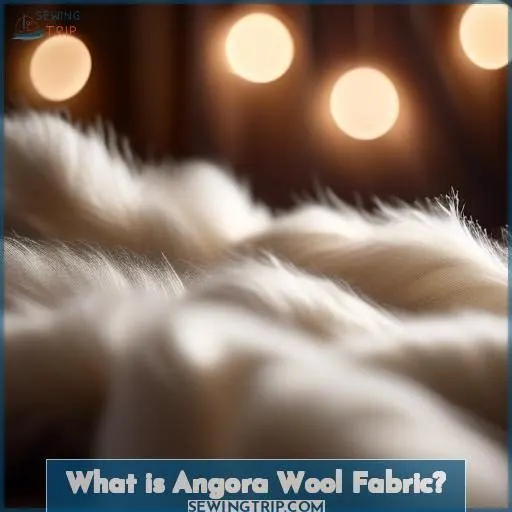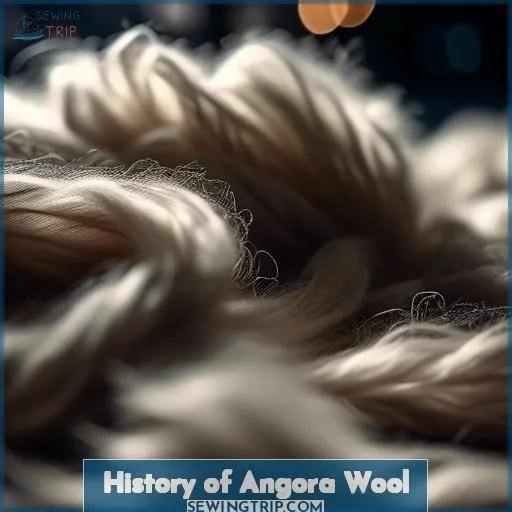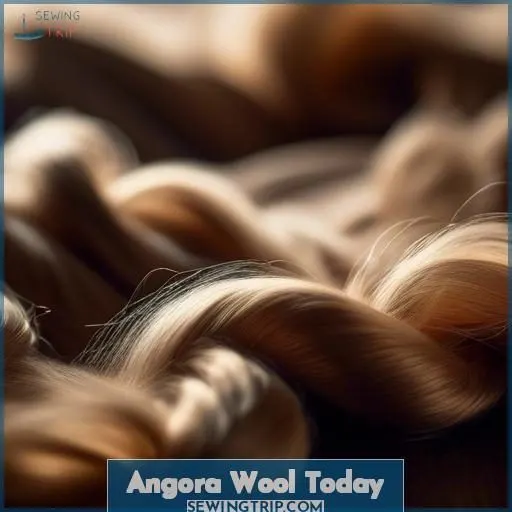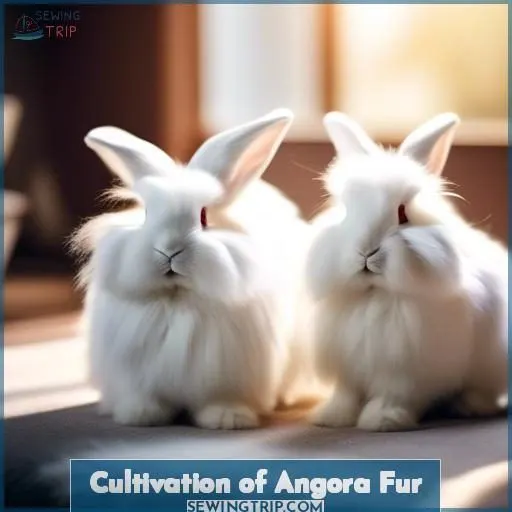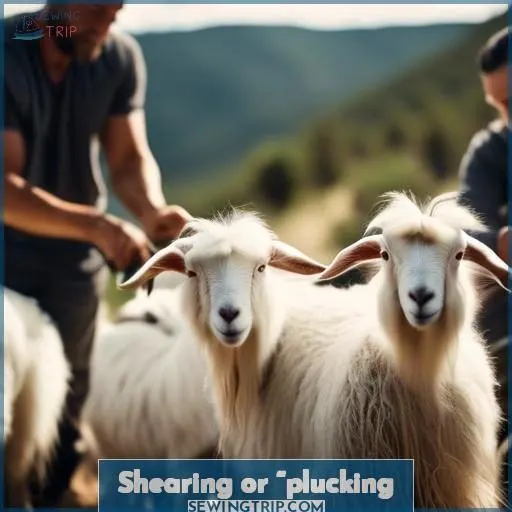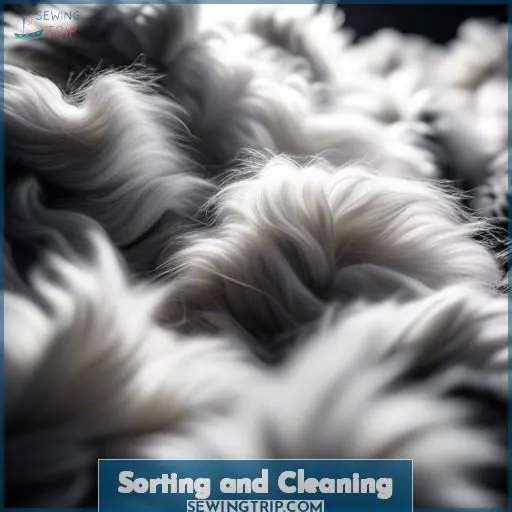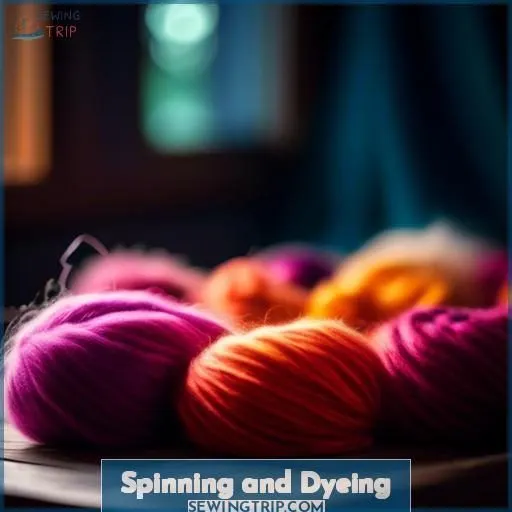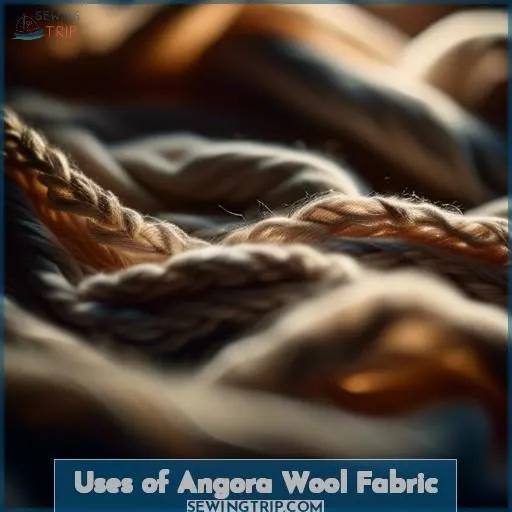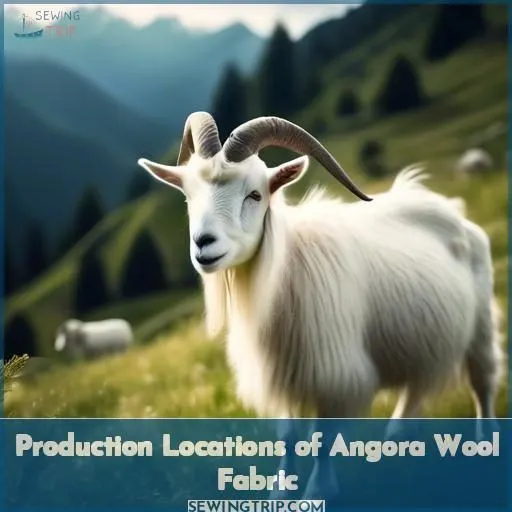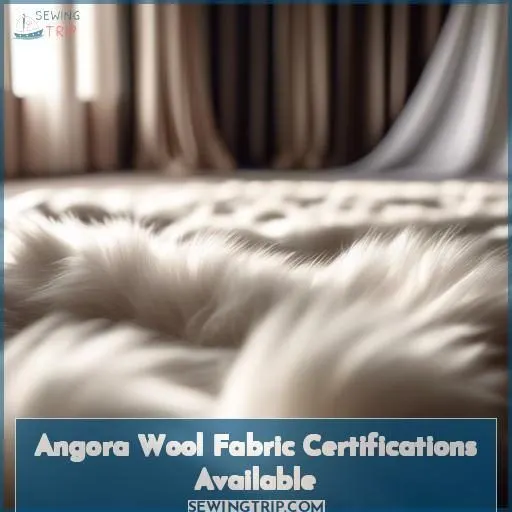This site is supported by our readers. We may earn a commission, at no cost to you, if you purchase through links.
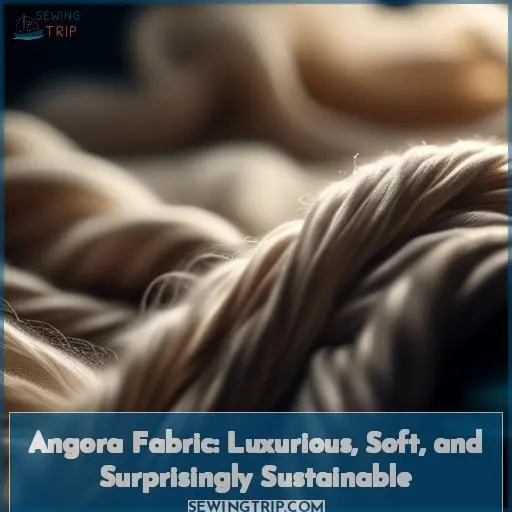
Angora fabric is a luxurious, soft, and surprisingly sustainable textile fiber harvested from the fur of Angora rabbits. Its fine, delicate fibers (12-16 microns) create a unique halo-like effect, making it both warm and non-allergenic.
Originating in Ankara, Turkey in the 18th century, Angora wool was prized by French nobility and later saw large-scale production in the US.
Today, ethical sourcing and sustainability are paramount, with a shift towards humane practices. You’ll discover more about this exceptional natural fiber and how it’s cultivated, processed, and used in high-end apparel and home goods.
Table Of Contents
- Key Takeaways
- What is Angora Fabric?
- What is Angora Wool Fabric?
- History of Angora Wool
- Angora Wool Today
- Cultivation of Angora Fur
- Shearing or “plucking
- Sorting and Cleaning
- Spinning and Dyeing
- Uses of Angora Wool Fabric
- Production Locations of Angora Wool Fabric
- Angora Wool Fabric Certifications Available
- Frequently Asked Questions (FAQs)
- Conclusion
Key Takeaways
- Angora fabric is a luxurious, soft, and sustainable textile made from the fur of Angora rabbits.
- It is characterized by its fine, delicate fibers (12-16 microns) and halo-like effect, making it both warm and non-allergenic.
- Angora fabric has a rich history dating back to the 18th century in Ankara, Turkey, and was later popularized by French nobility and large-scale production in the US.
- Ethical sourcing and sustainability are becoming increasingly important in the angora wool industry, with a shift towards humane practices and certifications like the Responsible Wool Standard (RWS) and OEKO-TEX.
What is Angora Fabric?
Angora fabric is made from the fur of Angora rabbits, known for its fine, fluffy texture and luxurious softness. This fabric stands out for its warmth and shiny appearance, making it a popular choice for high-end garments.
What is Angora Wool Fabric?
Angora wool fabric is a luxurious and soft material that comes from the Angora rabbit, a breed known for its fine, thin fibers. The fabric is characterized by its halo-like effect, which gives it a fluffy appearance, and its silky texture. It’s often used in apparel such as sweaters, coats, scarves, and gloves, as well as in blankets, pillow covers, and knitting.
Angora wool is also known for its warmth and light weight, and it felts easily, making it suitable for various textile applications. However, the production of angora wool has been subject to controversy due to concerns about animal welfare and the use of cruel practices in some factories, particularly in China where the majority of angora wool is produced.
History of Angora Wool
Angora wool has a rich history that dates back to the 18th century in Ankara, Turkey. Originating as a prized possession of Turkish nobility, it gained popularity among French nobility and eventually spread across Europe. The first large-scale production began in the early 20th century in the United States. Angora rabbits were bred for their luxurious wool, which is derived from their fine undercoat and guard hairs. The breeds of angora rabbits include English, French, Satin, Giant, and German, each with distinct characteristics and wool qualities. English Angoras are known for their softness and lack of guard hair, while French Angoras have a thicker undercoat and are easier to maintain. Satin Angoras have a unique sheen, and Giant Angoras are the largest breed, producing a high yield of fiber. German Angoras, while not officially recognized by the American Rabbit Breeders Association, are common in the United States and Canada, and are known for their dense, non-matting wool.
Angora wool has been used for various purposes, including apparel, blankets, and knitting. Today, ethical sourcing and sustainable production methods are becoming increasingly important in the angora wool industry. Consumers are becoming more aware of the potential welfare concerns for angora rabbits, leading to a demand for more ethical and sustainable practices in angora wool production.
Angora Wool Today
Today, the spotlight on angora wool radiates brighter than ever, not only for its silky charm but for the ethical practices underlying its acquisition. As you drape yourself in the warmth of angora fabric, be aware that the future of angora is progressing toward humane and sustainable fashion.
This transition isn’t only about animal well-being; it’s about embracing a movement that prioritizes sustainability and angora ethics. The journey of angora wool, from rabbit to runway, is becoming a reflection of the impact of ethical angora harvesting.
Cultivation of Angora Fur
Angora rabbit well-being is a critical aspect of cultivating angora fur. Ethical shearing practices are essential to guarantee the welfare of these animals. Sustainable angora production involves alternative sources like synthetic angora, which imitates the texture and properties of natural angora wool but doesn’t involve the use of real rabbits. Health benefits of angora include its softness and warmth, making it a choice for various clothing items. Angora rabbits are relatively easy to care for, requiring regular grooming to maintain a clean and matt-free coat. They need extra protein to support constant wool production, and their living conditions should provide ample space for movement and social interaction.
Cultivation of angora fur involves the natural molting process of angora rabbits, which occurs three to four times a year. During this period, rabbits are sheared or plucked to collect the wool. Plucking is considered a superior technique as it yields longer hairs, which can produce more valuable yarn. However, ethical shearing practices are critical to prevent harm to the animals. Angora rabbits should be kept in clean, spacious environments that allow them to exhibit natural behaviors and avoid stress.
The choice between plucking and shearing depends on the breed of angora rabbit. For example, the German angora doesn’t naturally molt its wool, so shearing is common practice. However, hand harvesting is also possible for this breed, as the wool can be easily removed from the back, bib, and stomach.
Shearing or “plucking
Regarding Angora wool fabric, the shearing or plucking technique is vital to its production. This process entails extracting the soft, delicate fur from Angora rabbits, which is subsequently converted into the luxurious and cozy fabric we’re familiar with.
However, the well-being of these animals is a major concern in this industry. Humane production methods, such as gentle plucking, are paramount to safeguarding the health of the Angora rabbits.
Consumer cognizance and demand for compassionate alternatives are propelling the transition towards sustainable practices in Angora wool production.
Sorting and Cleaning
Once you’ve gently gathered the rabbit wool, it’s time to sort the wheat from the chaff—or in this case, the superior fibers from the not-so-fluffy. Here’s how you’ll make sure your angora remains exceptional:
- Employ thorough sorting methods to separate the finest, softest fibers.
- Utilize cleaning techniques that preserve the wool’s natural warmth and softness.
- Prepare the fiber with care, protecting its fluffy aura.
- Prioritize yarn quality by choosing ethically sourced, pristine wool fibers.
Spinning and Dyeing
Spinning and dyeing are critical steps in the production of angora wool fabric. These processes are essential for creating the soft, silky, and warm fabric that’s highly sought after for various clothing and accessories.
First, let’s discuss spinning. Angora wool is unique in that it can be spun directly from the rabbit, without the need for cleaning or carding. The fiber is usually combed first to free it from any tangles or mats. After it has been plucked, the staples are kept parallel so that it will be easy to draft during spinning. Prime angora can be carded, but it’s not necessary. Angora that’s removed during combings can also be spun into yarn. It will usually have little snarls in it, which may make it impossible to spin a smooth even yarn. But in some cases, carefully carding the combings will remove the snarls. If the snarls can’t be removed, you can still spin the fiber, but it will make an interesting textured yarn.
Now, let’s move on to dyeing. Angora wool is known for its ability to blend easily with other fibers and for being easy to dye. The fiber is naturally white, but it can be dyed in various colors. Determining the color of your angora is easy if you follow a few simple guidelines. All colors are based on black, blue, chocolate, or lilac. Blue and Lilac are the dilute versions of black and chocolate. With the exception of sheen in the satin angora, colors across the 4 angora breeds are the same.
When it comes to dyeing techniques, there are several options available. One method involves using aqueous (neutral) and acidic mediums to extract the dyes from plant-based sources. The extraction protocol involves heating the ground plant powder with water and filtering the resultant extract to guarantee its purity. The wool yarn and the extracts are then exposed to microwave radiation to enhance the dyeing process.
In terms of sustainability, there are efforts being made to develop more sustainable dyeing methods. For example, the use of bio-mordants like red sumac, pomegranate, and weld can help improve the dyeing process without harming the environment. Additionally, the use of plant-based dyes can reduce the environmental impact of the dyeing process.
Angora wool can be blended with other fibers, such as wool, to create yarns with different properties. The choice of fiber blends, yarn weights, and dye techniques can greatly affect the final product’s appearance and performance.
Uses of Angora Wool Fabric
Explore the versatility of angora wool fabric, a luxurious and sustainable fiber with a rich history. From cozy sweaters to elegant scarves, angora wool is used in a variety of high-end apparel and home goods.
Ethical sourcing and sustainable practices guarantee the welfare of angora rabbits and minimize environmental impact. Angora fabric is often blended with other wools, such as mohair, to enhance its properties.
As a natural, biodegradable fiber, angora wool is a responsible choice for those seeking luxury without compromising on ethics or the environment.
Production Locations of Angora Wool Fabric
Angora wool fabric is a luxurious and sustainable material that has a rich history and a variety of uses. It’s primarily produced in China, where the vast majority of the world’s angora wool is sourced.
Concerns about animal welfare and ethical sourcing have led to a growing demand for more sustainable and ethical production methods. In response, certifications such as the Responsible Wool Standard (RWS) have been established to guarantee that angora wool is produced ethically, sustainably, and with consideration for the welfare of the animals involved.
Additionally, there are also other certifications like OEKO-TEX and USDA or European Commission that may certify organic Angora wool. These certifications provide assurance that the angora wool used in products is produced in a manner that doesn’t negatively impact any segment of the supply chain.
Angora Wool Fabric Certifications Available
Angora wool fabric is a luxurious and soft material that’s derived from Angora rabbits. It’s known for its fine fibers, which are typically between 12-16 microns in diameter, and its halo-like effect. Angora wool is also highly sought after for its warmth and lack of allergenic properties. The history of angora wool dates back to the 18th century, when it was first bred in Ankara, Turkey. It became popular among the French nobility in the 19th century and large-scale production began in the early 20th century in the US.
The production of angora wool involves cultivating the fur of Angora rabbits, which are sheared or plucked to remove the loose hair. The wool is then sorted, cleaned, spun, and dyed before being used to create various products such as apparel, blankets, and pillows. The majority of angora wool is produced in China, where factory farms often engage in cruel practices. However, ethical angora wool producers can be found in the US and other Western countries.
When it comes to certifications for angora wool, the Responsible Wool Standard (RWS) is the most respected. This certification guarantees that the angora wool is produced ethically, sustainably, and in ways that don’t negatively impact any segment of the supply chain. Angora wool that was produced ethically and organically may also be eligible for OEKO-TEX certification. The USDA or European Commission may also be willing to certify organic angora wool.
If you’re interested in sourcing angora fabric, consider looking for certifications like Angora Welfare Standards or RWS (Responsible Wool Standard) to support sustainable angora production. You can also explore online business-to-business (B2B) platforms that connect buyers with suppliers, such as Alibaba, ThomasNet, or Global Sources. Additionally, textile directories and industry networks can provide information about fabric suppliers, while local textile markets may offer angora fabric from vendors who meet your specific requirements and quality standards. Always make sure that any supplier you consider meets your ethical sourcing practices and certifications, especially when dealing with materials like angora, where animal welfare concerns may arise.
Frequently Asked Questions (FAQs)
What is the material abbreviation for angora wool?
The magical moniker for magnificent, malleable angora is ‘AG‘, capturing its alluring character. This resilient, refined fiber flaunts finesse, fashioning fabulous, fleecy fabrics fit for the finest fashionistas.
Is angora wool biodegradable?
Yes, angora wool is biodegradable – its fine, fuzzy fibers naturally decompose over time. This eco-friendly feature makes it a sustainable textile choice, though ethical production practices are essential to take into account as well.
What is the average lifespan of an angora rabbit in the wild?
The average lifespan of an angora rabbit in the wild is 7-12 years. That’s quite a long and fulfilling life compared to the measly 2 years angora rabbits endure on farms before being slaughtered. Heartbreaking, isn’t it?
How does the production of angora wool impact the environment?
Did you know that the angora wool industry produces over 3,000 tons annually? Sadly, this comes at a steep environmental cost – the intensive farming practices deplete natural resources and generate significant greenhouse gas emissions.
What are the ethical concerns surrounding the production of angora wool?
The heartbreaking truth is that angora rabbits endure horrific cruelty – they’re confined in tiny cages, painfully sheared, and eventually slaughtered. Ethical consumers must demand humane alternatives to this inhumane industry.
Conclusion
Undeniably, angora fabric is an extraordinary textile fiber with an exceptional history and a brilliant future. This sumptuous and sustainable fiber provides unmatched warmth, softness, and hypoallergenic properties, making it a highly sought-after material for premium apparel and home goods.
With ethical sourcing and humane practices leading the way, the future of angora fabric appears promising, meeting the increasing demand for environmentally responsible and animal-friendly textiles.
Incorporating this exceptional angora fabric into your wardrobe or home decor is a worthwhile consideration.

